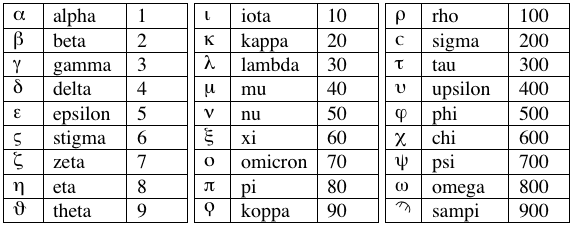

Each page of the Pauline codex includes a page number centered at the top of the page. Before the invention of the codex, books and other texts were written in the form of a bookroll, consisting of many columns. In a roll, the columns could be numbered, but this was not a very common feature. However, many New Testament codices used page numbers, and this was probably quite useful to the reader when trying to locate a specific passage in the text.
The numerals used for the page numbers are typical Greek numerals; each letter stands in place of a number, and the total value of the number is the sum of the individual values of the letters. Thus, in the example above the number represented is 41, which is obtained by adding 40 (the value of mu) and 1 (the value of alpha). A complete list of letters and their values is given below. Some of the letters may be unfamiliar, since Greek numbering continued to use archaic letters (such as stigma, koppa, and sampi) even after those letters had dropped out of common use in the Greek language.
These page numbers were very useful to the modern scholars who first obtained this codex in a very fragmentary state. By comparing the numbers on "conjugate pairs" of pages (i.e. two pages which were originally one sheet of papyrus), they were able to accurately estimate the number of pages that originally made up this codex. One such conjugate pair consisted of pages ΜΗ (48) and ΡΝΘ (159). Since the single-quire construction of the codex means that the number of pages before any leaf is the same as the number of pages after its conjugate pair, we know that the original codex had 207 pages, or 104 leaves (accounting for the fact that the front of the first leaf was left blank). The matter is confused by the fact the scribe numbering the pages mistakenly skipped over what should have been pages 100-101, and so the page numbers after that point in the codex are all off by two.
